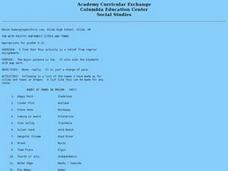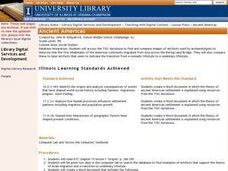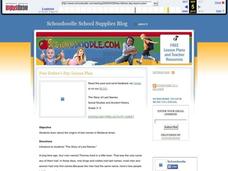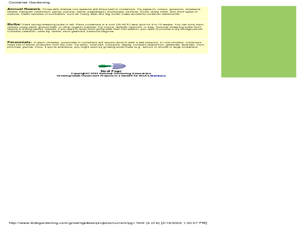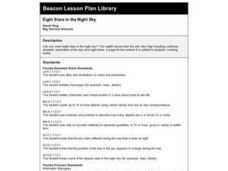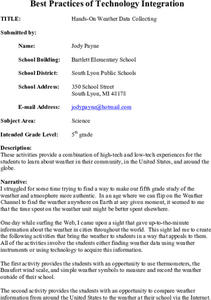Curated OER
Rape: Psychology, Prevention and Impact
Young scholars are introduced to the characteristics of rape. As a class, they identify statements as either facts or myths about rape. In groups, they complete a survey to identify their own perceptions about rape and compare them...
Curated OER
Beverage Tests
Learners investigate the pH of a liquid. In this middle school mathematics/science lesson, students collect and analyze data regarding the pH of various liquids. Learners display their data in various types of graphs as they consider...
Curated OER
Advisory in Action
Learners recognize that there are many ways to contribute to the community and the common good. In this importance of philanthropy lesson plan, students complete a worksheet to understand the community needs, how it is affected and what...
Curated OER
Community Foundations and Procedure
Students understand what a community foundation is and how it gets input from the community. In this community foundation lesson, students form an advisory board to give suggestions. Students learn procedures to hold meetings to agree on...
Curated OER
Taking the Mystery Out of Mesopotamia
Students locate Mesopotamia on the map and explain the importance of its location. In this Mesopotamia lesson, students understand why the new discoveries of Mesopotamia were so important to civilization. Students participate in...
Curated OER
Online Scavenger Hunt
Students participate in an online scavenger hunt to answer questions posed by the teacher. In this Internet search lesson, students are given specific questions and they have to use the Internet to locate the answers. There are links...
Curated OER
Methamphetamine: A Threatening Scourge on Teens, Families, and Communities
Students examine how methamphetamine alters the brain and the facts about it. In this brain chemical addiction lesson students read articles on methamphetamine and take a quiz.
Curated OER
Fun With Pacific Northwest Cities and Towns
Intended for fun only, learners play with the names of cities common to their region or state. This lesson includes a list of cities in Oregon and not much else. What you and your class choose to do with your list of cities is up to you.
Curated OER
Out and About: Football
Students explore British football. In this current events lesson, students visit the National Football Museum, the Scottish Football Museum, and the Manchester United Museum online or in person to discover the history of the game as well...
Curated OER
Ancient Americas
Seventh graders compare artifacts used by archaeologists to theorize the first inhabitants of the Americas migrated from Asia across the Bering Land Bridge.
Curated OER
Valentine's Kindness
Learners learn about kindness. In this kindness lesson, students bring a stuffed animal from home and discuss times they have felt sad and what they have done to cheer up others. Learners discuss why it is important to be kind. An...
Curated OER
The Story of Last Names
Students examine the origins of common last names. For this lesson on last names, students read about how last names came to be and examine the meaning behind a few common last names.
Curated OER
Could the Civil War Been Avoided Through Compromise?
Students determine whether the American Civil War could have been avoided. In this Civil War instructional activity, students examine primary and secondary sources to prepare to participate in a classroom debate that requires them to...
Curated OER
Gardening in Containers
Learners plant a garden. In this gardening lesson, students use containers to plant a garden. This lesson provides a good source of information for teachers who wish to begin their class's own container garden.
Curated OER
Lego Robot Competition
Students are introduced the "Lego Robot Competition", demonstrate Lego Data Control System that is controlled through tethers by laptop computers. High School students create the competition, organize the media coverage, and conduct the...
Curated OER
Hoopla Shuffle: Gross Motor Development
Using cones and large hoops, have your athletes move the hoops around the gym using only their feet. They must do so within various parameters: both feet inside or outside the hoop, one in and one outside it, or twirling it around one...
Curated OER
Eight Stars in the Night Sky
First graders explore the day and night sky. They complete a number 8 page for their counting books.
Curated OER
What's This Number?
Students practice the correct way to write numbers. In this language arts and math lesson, kindergarten students not only practice their number formations, but they also practice holding their pencil in the correct manner.
Curated OER
Hands-On Weather Data Collecting
Fifth graders use Internet sites to complete a study of weather and atmosphere. They compare weather data from cities around the world. They use thermometers, the Beaufort wind scale, and simple weather symbols to measure weather around...
Curated OER
Moving Out
Students determine their cost of living. In this determining their cost of living lesson, students think of ten necessary things they would need if they moved out of their parents house. Students research the cost of renting an...
Curated OER
Predictable Chart/Sentence Building with "Goodnight Moon"
First graders work on a series of modeled reading and writing lessons based on "Goodnight Moon." students work on pages of a predictable class book.
Curated OER
Decoding DNA
Third graders complete their KWL charts from the first lesson of the unit as a review for the summative. Then they decode a secret message using the four basic components of DNA, adenine, cytosine, guanine and thymine.
Curated OER
Using e-mail to Communicate with Students in an Inner City; Celebrating Diversity through a Penpal Program
Students communicate with students at another school through e-mail to help them become better acquainted with using a PC and e-mail. In the second lesson plan, the same type of method is used to explore diversity among communities.
Curated OER
Calendar Math
Students count and name the numbers and days on the calendar in order to determine the date. They identify the month and the entire date, and determine the pattern shown on the calendar markers. Students then calculate how many days...









